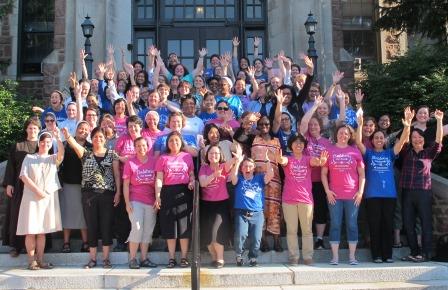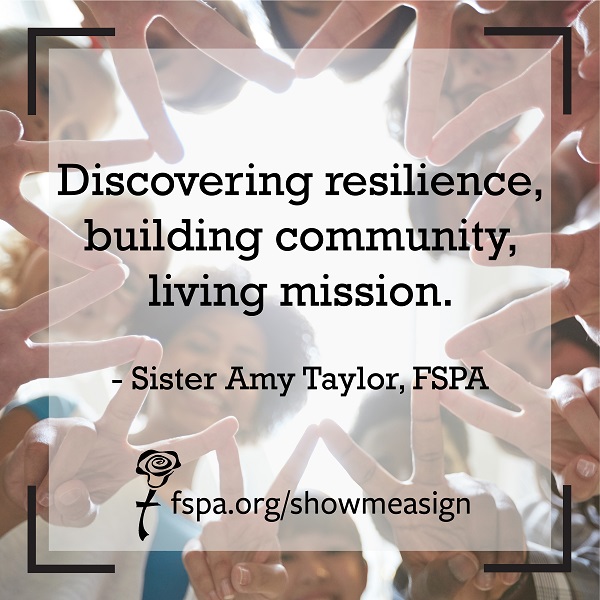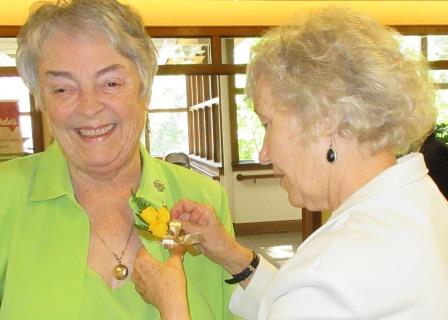- Related Content
Sustaining the future of organic farming
“The Villa garden and Sister Lucy ignited my love for growing good food!”
This is the perennially ripe and juicy fruit Bethanee Wright, a former Viterbo University student, harvested from her agriculture internship seven years ago in the care for creation that is FSPA...
Italian Sangria for Corpus Christi

Ingredients:
2 C Tuscan red wine, (May substitute grape or cranberry juice)
3 C freshly squeezed orange juice
1/2 C freshly squeezed lime juice
3/4 C Tuaca (a citrus-vanilla liqueur) or Triple Sec
1/3 C vermouth (optional)
1/2 C limoncello or lemon juice
1/4 C sugar
Ice
Orange slices, for garnish
Lemon slices, for garnish
Lime slices, for garnish
Blueberries for garnish
Prosecco (optional)*
Makes 1 pitcher
Instructions:
Combine all ingredients (except ice cubes) in a large pitcher and mix well. Pour Sangria over ice in a glass.
*Add Prosecco to glass of Sangria or if you prefer, add Prosecco directly into Sangria pitcher and mix. Either way it adds a zing to the drink if you like bubbly.
Story:
On a hot summer day, who doesn’t enjoy a cool drink? This festive recipe for Italian Sangria is fruity, refreshing and can be made with or without alcohol. Sangria comes from the Spanish word sangre meaning blood, an element of life itself. This recipe and picture above comes from Christina's Food and Travel website. She is an Italian American who honors her southern Italian heritage in travel and cooking.
My grandfather was a winemaker like his immigrant mother. He would offer his dry and potent vino to guests and family at any hour. One winter day when he and I disagreed about something I wanted to do, I said “no” when Papa offered me a glass. As his face dropped, I realized deeply that his wine was a gift of himself, his love and his heart. Surrendering my small desire, I poured us both a glass. Salute! It was a moment that deepened my appreciation for him and how he poured himself out for others. It connected me more closely with the life poured out in love by our Jesus.
If you would like to be notified when we share new recipes, be sure to scroll to the bottom, provide your email address, check the box confirming you are not a robot, click on a few photos to prove it and click subscribe! You will then receive an email after each new post. Remember, we're always looking for new recipes, so keep sending them to ecopact@fspa.org!
Two Basic Salad Dressings

ITALIAN STYLE SALAD DRESSING
Ingredients and Directions:
1. Measure 2/3 C olive or vegetable oil into bowl or pint jar with a cover.
2. Add 1/3 C of your favorite vinegar or other acid of your choice, such as lemon juice
3. Add ½ tsp Dijon mustard and 1/8 tsp each of salt, pepper, dried basil, oregano and garlic powder OR 1/2 tsp Italian Seasoning mix.
4. Whisk with a whisk or fork or shake a covered jar vigorously to help the dressing emulsify.
5. Taste and adjust your ingredients.
6. Pour a small amount over greens and toss with two forks or spoons. You want the greens to be coated, but not “swimming” in dressing with no puddle at the bottom of the salad bowl! Add more, as needed.
7. Label the container and store any leftovers in the fridge. You may need to shake it before using to remix the oil and vinegar. Double or triple the recipe to have extra on hand! This also makes a good dip or a marinade for roasting vegetables.
BASIC CREAMY STYLE SALAD DRESSING RANCH STYLE
Ingredients and Directions:
1. Combine 1/4 C each of mayo and sour cream, 2 T milk, 1 tsp lemon juice into bowl or jar with a cover.
2. Whisk or shake covered jar vigorously to help the dressing emulsify.
3. Add seasonings (1/4 tsp dry dill weed, 1/8 tsp each garlic powder and onion powder, salt and pepper to taste. Repeat step 2, taste and adjust your ingredients!
4. Pour a small amount over greens and toss with two forks or spoons. You want the greens to be coated, but not “swimming” in dressing with no puddle at the bottom of the salad bowl! Add more, as needed.
5. Label the container and store in the fridge. You will need to shake it before using.
This also makes a great dip or addition to baked potatoes! Add more sour cream and / or mayo to make it thicker, if you like!
Note: The photo above come from Victoria of Mason Jar Recipe whose site also features Mason Jars as gifts, decorations and other crafts.
Variations: The Ranch above can be improvised with salsa and taco seasonings to make a Fiesta Dressing. Sweeteners like honey, various mustards, fruit puree or various vinegars with one with complex flavor like balsamic can make the vinaigrette your own.
If you would like to be notified when we share new recipes, be sure to scroll to the bottom, provide your email address, check the box confirming you are not a robot, click on a few photos to prove it and click subscribe! You will then receive an email after each new post. Remember, we're always looking for new recipes, so keep sending them to ecopact@fspa.org!
Story:
Making salad dressing from scratch is a pretty quick, healthy, economical way to add taste to the variety of greens we now enjoy from the garden, the farmer's market or the produce aisle. Reusing the jars makes sense, too! You can do so for a special occasion or make home made part of your routine.
Tamra Dickinson and I shared these recipes with our after school cooking class students at Hillside Elementary in spring 2022. It was fun to watch them wash greens and spin them dry in make-shift kitchen towel salad spinners. They shook jars of dressing ingredients with every muscle they had and we all enjoyed a spring kale salad!
I don't recall bottled salad dressing on the table until I was college age. They taste good, but the ingredient list often includes high fructose corn syrup and ingredients far too hard to pronounce. For our family, salad was usually spring garden lettuce or iceberg lettuce with a vinegar and oil dressing made in the bowl right before dinner. More bitter greens like endive and chard were for the adults. The few times we visited a restaurant, one treat was serving yourself from one of the 3 offerings of salad dressing, typically French, Bleu Cheese and Vinegar and Oil in those cool decanters we passed around the table. One legendary Italian restaurant in Hurley, Wisconsin swore its staff to secrecy when making their signature Caesar salad dressing!
What are your salad and dressing habits or memories? What's Cooking America? shares histories of famous dressing makers like "Marzetti", "Hellmann", Kraft Cheese Company; dressings like Thousand Island, Green Goddess and Russian; and salads like Caesar, Cobb, King Louis, Panzanella and Nicoise.
Roasted Squash Seeds - Minimize Food Waste!

Ingredients:
Clean, dry seeds. (See below for tips on preparing seeds for roasting.)
Olive oil or your favorite vegetable oil.
Salt
Seasonings of your choice. Suggestions include:
• acorn squash (with olive oil and salt)
• butternut squash (with olive oil, fennel seed and salt)
• delicata squash (olive oil, coriander seeds, curry powder and salt)
• spaghetti squash (olive oil, red chili flakes, and salt)
• kabocha squash (allspice, cardamom, and cloves)
• Create your own favorite spice and herb mix such as pumpkin pie spices, Italian spice, taco seasoning!
Directions:
Start with clean dry seeds. This is the most time consuming, but kids can help!
• Cut the squash in half from stem to bottom. (For a pumpkin that will be carved, cut a circle in the top!) Use your hands or a large spoon to pull out the seeds into a large bowl Try to squeeze the seeds out of this substance, leaving as much of the pulp behind as you can. There are pockets of seeds in the cavities of the pulp, so be sure to root around in the corners.
• Fill the bowl with cold water and use your hands to squish the seeds together to remove the slimy pulp. The seeds will rise to the surface. Skim them off and spread them out to dry.
• You can also put the seeds in a strainer and using your kitchen sprayer to loosen the pulp.
• Turn seeds out onto a clean absorbent dishcloth and pat them dry.
• If a little pulp sticks to the seeds, it will cook away during roasting.
Boil (optional): If the seeds are particularly tough, such as pumpkin and kabocha seeds, you can boil them in salted water for about 10 minutes. This can help soften the outer shells slightly and make them easier to roast.
Dry the seeds: Spread the cleaned seeds on a clean kitchen towel to dry. Allow them to air-dry for a few hours or use a towel to pat them dry.
Preheat the oven to 375 degrees F.
Coat and Season: In a bowl, toss the dried seeds with a small amount of olive oil or vegetable oil. Use enough oil to coat the seeds lightly but not so much that they become greasy. Add your choice of seasonings and salt to the bowl. Toss the seeds to evenly coat them with the oil and seasonings.
Roast: Spread the seasoned seeds in a single layer on a baking sheet lined with parchment paper or a silicone baking mat. Roast the seeds in the preheated oven for about 15-20 minutes, stirring occasionally to ensure even roasting. They will start to "pop’". Keep a close eye on them to prevent burning.
Test for doneness: The seeds are done when they turn golden brown and have a crispy texture. Taste a few seeds to make sure they are cooked to your desired level of crunchiness.
Cool: Once the seeds are roasted to your liking, remove them from the oven and let them cool completely on the baking sheet. They will become even crunchier as they cool.
Store: Once the seeds are completely cooled, transfer them to an airtight container. Properly stored, roasted squash seeds can stay crispy and flavorful for several weeks.
Uses:
- Serve as a healthy snack, as an appetizer or as part of a cheese or “charcuterie” board.
- Add to a fall salad as you would use nuts or croutons.
- Garnish a fall soup with roasted seeds, especially if the soup contains squash.
- Add to granola or trail mix.
- Bake them into seedy crackers or breads.
Story:
Roasting seeds from winter squash is a good way to use as much of this "sister" as possible, reducing food waste. Sue Moran says “For some people, it’s a cherished fall ritual. Usually, it’s after the family jack-o-lantern gets hollowed out for carving and everybody gets all excited to roast the seeds… only to be super disappointed at how tough they can be! Turns out all the other winter squash have much better seeds for roasting.”
Sue reminds us, "Farmers markets and roadside stands are great sources for different varieties of winter squash ~ and all of them (and their seeds) are edible. Delicata, butternut, acorn, even spaghetti squash seeds can be roasted. These seeds are smaller, and more tender and flavorful than pumpkin seeds which are more fibrous."
As mentioned in last week’s story about “Three Sisters’ Soup”, most summer and winter squash are indigenous to the Americas. Squashes are one of the oldest known crops–10,000 years by some estimates of sites in Mexico. Squash was first used in its wild form. Since squashes are gourds, they most likely served as containers or utensils because of their hard shells. The seeds and flesh later became an important part of the pre-Columbian (before the arrival of Columbus!) Indian diet in both South and North America and has become one of the world’s most cultivated crops.
Knowing where our food comes from can help us to appreciate how the earth provides and our responsibility to use it with gratitude. As we read about how humans nurtured a variety of foods for our table, we are invited to reverence and use them well. It is my hope that awareness of the culture of Indigenous Peoples challenges white people to learn more about Native values, to risk relationship (encuentro) with Native Americans and to join their work of bringing justice, peace and unity between all members of the human and other than human family.
Moran of The View from Great Island relays: "For some people, roasting squash seeds is a cherished fall ritual. Usually it’s after the family jack-o-lantern gets hollowed out for carving and everybody gets excited to roast the seeds… only to be super disappointed at how tough they can be! Turns out all the other winter squash have much better seeds for toasting.
"Farmers' markets and roadside stands are great sources for different varieties of winter squash, as seen in the picture above by Sue Moran . She says, "and all of them (and their seeds) are edible. Delicata, butternut, acorn, even spaghetti squash seeds can be roasted…these seeds are smaller, and more tender and flavorful that pumpkin seeds which are more fibrous."
Enjoy!
Healthy Snack Ideas and Eating Mindfully

Snacks offer extra energy, a vital mini break or a tasty way to stimulate appetites as guests arrive for holiday gatherings. Snack foods come with pitfalls like lots of fat, hidden salt, processed sugar, empty calories, and overeating. Scroll through these healthy snack ideas to get your snack creativity going. They are provided in part (as is the photo above) from the staff at International Functional Foods Association. This year my hope is that they help keep me healthy and deepen the practice of mindfulness in the midst of a few indulgent holiday treats!
SIMPLE SNACKS
Nutty Trail mix A batch of trail mix blend is a quick and easy way to have a healthy snack on hand. Use raw unsalted nuts, if possible. Stick to a ¼ cup serving size to keep it healthy.
How to: Pick your favorites from this list and mix away! Raisins, Almonds, Cashews, Brazil nuts, Macadamia nuts, Dark chocolate, Banana chips. Add your own favorites!
Benefits: Nuts are nutritionally dense, high in protein, fiber, and antioxidants. They may support weight loss and reduce inflammation, plus lower risk of heart disease. Raisins are a healthy way to add sweetness. Dark chocolate balances the nuts while providing antioxidants and can support heart and brain health.
Popcorn is one of the best snacks! Ideally, it needs to be air popped or made with as little oil as possible and lightly seasoned. Microwave or movie theater popcorn unfortunately aren’t healthy options.
How to: Pop plain ol’ popcorn then season it, making sure to stay light on salt and resist the urge to drown it in butter. Try lightly seasoning it with olive oil, curry powder, or nutritional yeast!
Benefits: Popcorn has high satiety, so even a little can help make you feel full. It has lots of fiber and antioxidants.
Citrus fruits are a quick and easy to grab. Mandarins and oranges are an especially good pick during winter months and have a refreshing scent and health benefits.
Benefits: Fruits are full of fiber and fluid. You get antioxidants and a reduced risk of cardiovascular disease. Citrus has vitamins like potassium and vitamin C. Plus, it may be protective against health issues like diabetes, ulcers, hypertension, and more!
Dark chocolate
Benefits: Chocolate has lots of antioxidants plus it can also support heart and brain health. A few squares of dark chocolate can give you great benefits. Pick a bar with a cacao content of 70% or greater since that means more actual chocolate and less sugar. It also has been shown to improve mood!
SWEET SNACKS If you crave sweets, these snacks will satisfy your sweet tooth without jeopardizing your health. Healthy Banana Split or Fruit Sundae Here is a healthy take on the ice cream shop classic. Other fruits work as well.
How to: Peel and split a banana and place in a dish. Instead of ice cream, scoop yogurt of choice on top. Drizzle with honey or maple syrup. Sprinkle with cacao nibs, a few tiny chocolate chips or chopped nuts.
Benefits: Bananas support digestive health thanks to their fiber content. They provide potassium and vitamins B6 and C. Both bananas and yogurt have been shown to aid in weight management, so this is a great diet friendly option!
Homemade yogurt cups are fresher and healthier than most store bought versions, and you get complete freedom to make your own flavors!
How to: Dice fresh fruit of choice. Lightly mash fruit until it's juicy but keep some chunks. If desired, sweeten the fruit with honey or coconut sugar. Add Greek yogurt, or coconut, cashew, or almond yogurt as a dairy-free option.
Benefits: These are a filling high protein snack, which helps you feel full. Fermented foods have probiotic benefits which are great for gut health. The fruit provides fiber and antioxidants. While skipping the sweetener is best, using honey or coconut sugar which both have lower glycemic indexes, will help prevent a post snack energy crash.
Snack sized overnight oats Since you make this the night before, it’s a quick snack to grab before work.
How to: Combine old fashioned oats with milk of choice. Mix in a scoop of chia seeds (optional). Add raisins or other dried fruit. Refrigerate overnight in small containers.
Benefits: Oats control hunger and prevent blood sugar from spiking. They’re full of soluble fiber and antioxidants. Chia seeds provide protein and more antioxidants, plus they may also prevent blood sugar spikes and have a high satiety (aka how full a food makes you feel). Raisins are a sweet but healthy add-in thanks to their low-moderate glycemic index. They can also help to reduce your appetite and promote good oral health due to their texture. Glycemic index refers to the rate at which a carbohydrate food is digested into a simple sugar, raising blood sugar. Table sugar, white bread, potatoes have a high glycemic index and raise blood sugar quickly. Complex carbs like oats, brown rice, raisins have fiber which slows digestion as do protein rich foods.
Nut and seed bread with ghee Bread and butter is a worldwide staple snack. When made with whole grains, nuts and seeds bread it becomes a healthy AND functional snack.
How to: Ghee is butter without the milk proteins. It can be made at home from any butter and kept in a jar at room temperature. The Pioneer Woman has a recipe with clear directions.
Benefits: Nut bread has a high protein content which will help you feel full plus the nuts and seeds provide antioxidants, fiber, and can reduce inflammation and may lower risk of heart disease. Ghee is a perfect substitute for butter since it provides healthy fats without all the dairy solids. A drizzle of honey add some sweetness, antioxidants and minerals.
SAVORY SNACKS If you prefer salty snacks but want to limit fat and salt, consider the following:
Hard boiled eggs are quick and easy. You can make a batch to last the whole week.
How to: Put enough water into a saucepan to cover the eggs. When the water boils, carefully lower eggs into the water. Allow pot to come back to boiling. Set the timer for about 15 minutes. When it goes offdrain and cool the eggs in cold water to stop the cooking. This steaming process makes peeling them easier! Try new and fun seasonings beyond salt and pepper to add variety to this snack. Smoked salt, poultry spice blends, and chili powder are just a few.
Benefits: Eggs are high in protein but low in calories and saturated fats. Eggs are also high in vitamins A and D and support eye, nerve, and brain health.
Homemade chips Store bought chips are easy and tempting snacks, but you’ll thank yourself for making them out of sweet potato, kale or apples!
How to: With a sharp knife or mandoline, carefully slice sweet potatoes or use clean, dry pieces of kale. Bake for 30 minutes at 400, 350 for Kale. For Apples, crisp a low oven (about 200 degrees F or less) or a dehydrator until crunchy.
Benefits: The lack of all the salt and oil found in store bought chips. Sweet potatoes are full of fiber and beta-carotene, a precursor to vitamin A. Kale provides antioxidants and gives an immunity boost.
Baked cauliflower bites can be made ahead or enjoyed warm from the oven.
How to: Cut fresh cauliflower into bite sized portions. Toss with olive oil and your favorite seasoning, such as Italian, curry mix, paprika, garlic. Roast on a sheet pan until cooked and lightly crisp
Benefits: This can be an immune system boosting snack and both cauliflower and olive oil both contain antioxidants. Olive oil may help support heart and brain health.
Whole grain toast with avocado, tomato and mozzarella can be adapted for all diets.
How to: Toast bread and layer slices of avocado, tomato, and mozzarella. Drizzle with a little olive oil.
Benefits: Whole grain bread has more fiber, potassium, calcium, and magnesium than processed grains do. Avocado can support heart health while also providing fiber, key vitamins, and good fats. The fat also gives it high satiety to help you feel full. Tomato slices provide fiber and more vitamins, especially folate and vit C which can support vision health. Mozzarella provides some probiotics, can help reduce weight gain, and support bone health. A drizzle of olive oil adds flavor plus antioxidants.
Mini hummus tray
How to: Click on the link for an easy recipe from Simply Recipes with canned or home-cooked garbanzos. If you don't want to buy tahini, add a few toasted or raw sesame seeds to the processor or mortar and pestle for the taste of tahini.
Benefits: Hummus is a powerhouse snack with high fiber and lots of vitamins and minerals (folate, iron, vitamin B6, and thiamin). It has polyphenols, which may aid in digestive health, weight management, and issues like diabetes. For snacking, keep serving size to 2 tablespoons.
Pairing veggies with your hummus adds fiber and vitamins and few calories. Red bell peppers are a classic choice but also try sugar snap peas, carrots, or even homemade veggie chips from above!
Happy snacking! For more healthy snack ideas, check out suggestions from your favorite chef or from the International Functional Foods Association who offer a few more guidelines:
Portion size: IFFA says that snack foods should be about 10% of your daily calories. This usually is 150-300 calories depending on your needs. Snacking constantly is tempting, but more than two a day may put on some pounds if done as a regular habit.
Food groups! There are endless options but a good way to start is by picking an item from two food groups (like hummus + veggies). Or pick a strong functional food and build on that (like oatmeal + add ins). And if you need an easy single item snack, pick something with lots of fiber or from a food group of which you don't eat enough (like citrus).
Story:
Our beloved Labrador (nicknamed "Hoover" by his rescuers) ate each meal like a starved vacuum cleaner, as if someone might take the food away from him! The opposite of "hoovering", mindfulness is a spiritual practice that allows slowing down to savor each flavor, texture and smell. Slowing down to savor its flavor, we experience the pleasure of texture and smell. Attention to each bite can improve digestion and help us be aware of the feeling of fullness. A very common place to eat, believe it or not, is in a vehicle of some kind. Rather than eating on the run or without attention, set a calm table for meals and small snacks as meaningful breaks in the day. Take time to relax away from work and other tasks. Mindfullness about food allows us to change our focus and be nourished and refreshed by the gift of breaking bread with others or in our own companionship. How can we taste and receive the Bread of Life, if we don't savor food and make room for silence and mindfullness?
Roasted Root Vegetables and Storing Root Veggies
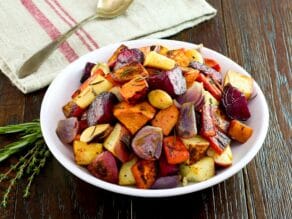
Ingredients:
1 pound yams (or sweet potatoes) – 2 small or one large, peeled
3/4 pound unpeeled red or Yukon gold potatoes, scrubbed clean
1/2 pound beets (red or golden), trimmed and scrubbed clean
1/2 pound large carrots, peeled and halved lengthwise
1 parsnip medium sized (4-5 oz), peeled and halved lengthwise
1/2 red onion, peeled
6 whole garlic cloves large sized
1/4 C extra virgin olive oil, divided
2 T fresh thyme leaves (or 2 tsp dried thyme)
5 sprigs fresh rosemary (or 3 tsp dried rosemary)
1 tsp ground cumin (can be omitted)
1 tsp kosher salt or more to taste
1/4 tsp black pepper or more to taste
Notes: Root vegetables have a sweet, earthy flavor that seems made for roasting. Serve as a side dish or add leftover cooked chicken or garbanzo beans at the last 10 minutes of cooking to heal the protein through. The recipe is easy to double on 2 cookie sheets and roasted at the same time for a crowd, a buffet or to freeze some. See below.
You can use any combination of root vegetables you like. If using red beets your other vegetables may take on a bit of red color. It is pretty, but if you don’t like it, use golden beets instead. The photo above and a short video of Oven Roasted Root Vegetables is from Tori Avey.
Advance Prep:
You can do all of the chopping, peeling, and measuring up to two days ahead. Place ingredients into a sealed refrigerator bag, seal and toss ingredients to coat, then refrigerate until ready to cook. Pop them in the oven when you’re ready to roast.
You can roast the vegetables up to two days ahead. Cook them until almost (but not quite) fully tender. Refrigerate in a sealed bag. Just before your meal, reheat in a 400 degree F oven for just a few minutes. By the time they’re heated through, they’ll be perfectly cooked. OR, put them on a cookie sheet in a single layer, freeze and bag them partially cooked for another meal!
Instructions:
Place a rack in the bottom of your oven and preheat oven to 400 degrees F. Unless indicated otherwise above, slice all vegetables into chunks roughly 1 1/2 inches wide. The more similar the size of the vegetable pieces, the more evenly they will roast.
Place cut vegetables and garlic cloves into a large mixing bowl. Add 3 T olive oil, fresh thyme leaves, ground cumin, kosher salt, and black pepper. Stir until all vegetables are evenly coated with oil, spice and herbs. Brush large rimmed baking sheet with remaining 1 tbsp olive oil. Spread the vegetables out evenly on the baking sheet. Place the rosemary sprigs on top of the vegetables, evenly spaces across the sheet.
Roast the vegetables in the oven for 15 minutes. Stir, bringing the chunks from the outside towards the center and the chunks in the center out towards the edges. Return baking sheet to oven and continue to roast until the largest chunks are tender and the edges are starting to turn golden/dark, another 15-25 minutes.
Remove the roasted rosemary sprigs and stir the vegetables (some leaves of rosemary will remain, this is good). Season with additional salt and pepper to taste, if desired. Vegetables can be served warm or at room temperature.
If you would like to be notified when we share new recipes, be sure to scroll to the bottom, provide your email address, check the box confirming you are not a robot, click on a few photos to prove it and click subscribe! You will then receive an email after each new post. Remember, we're always looking for new recipes, so keep sending them to ecopact@fspa.org!
Story:
Roasted root vegetables are a savory treat this time of year and you can make extra to freeze for a side dish or creamy soup! They exemplify the invitation to eat seasonally in winter. Storing Winter Vegetables Have you ever had potatoes or onions begin to sprout and soon spoil as they waited for you to use them?
The Spruce has some detailed recommendations like using soft or bruised vegetables first, which root vegetables should go in the fridge in a low humidity drawer and keeping onions and spuds in separate pantries or cupboards. Keeping winter veggies out of the light and providing good ventilation in wire baskets, a paper bag or even a cardboard box with holes can help reduce sprouting and spoilage of potatoes, garlic, beets and sweet potatoes. Our grand and great-grandmothers knew!
Recipes for Minestrone Soup and for a different kind of fast this Lent
Ingredients:
1 clove of garlic
2 small onions
olive oil
2 fresh bay leaves or 1 small dried
2 carrots
2 stalks of celery
2 large handfuls of seasonal greens, such as savoy cabbage, curly kale, chard, spinach
1 vegetable stock cube
1 14.5 or 15 oz. can of plum tomatoes
2 14.5 or 15 oz. cans of beans, such as cannellini, butter, or mixed
½ C dried pasta
Parmesan cheese, Grana Padano or vegetarian alternative, to serve
extra virgin olive oil
crusty bread, to serve
Directions:
1. Peel and finely chop garlic and onion. Put a large shallow casserole pan on a medium-high heat with 1 T of olive oil.
2. Add the garlic and the bay leaves, followed by the onions.
3. Trim and chop carrots and celery into rough 1/2” dice, adding to the pan as you go. Remove and finely chop any tough stalks from your greens and add to the pan. Cook for 10 to 15 minutes, stirring regularly, or until softened and caramelized.
4. Crumble in the stock cube, pour in the tinned tomatoes, breaking them up with your spoon, then add 1 tin’s worth of water. Pour in the beans, juice and all, then add a pinch of sea salt and black pepper.
5. Shred your greens and sprinkle into the pan, top up with 2 ½ C of boiling water, then add the pasta. Cover and simmer for 10 - 15 minutes, or until pasta is just cooked and the soup has thickened to your liking.
6. Season the soup to your taste, then serve with a grating of Parmesan cheese and a drizzle of extra virgin olive oil.
Notes:
- This recipe serves 8, so you’ll have plenty left over for lunches. To serve, reheat in a pan, stirring often until piping hot.
– Don’t waste any of the greens – remove tougher stalks, finely chop and add them to the base of your soup with the onion, carrot and celery.
– This soup is great for using odds and ends from your dried pasta packets. Put whatever you’ve got in a clean dish towel, then smash it all with a rolling pin, so it’s all about the same size.
– Use whatever herbs you’ve got. Rosemary or thyme leaves would be delicious, or even a sprinkling of dried herbs.
– You can add other chopped veg when you’re frying the onions like leek, zucchini or potato.
– Use whatever stock you like.
– Instead of grated Parm, you could use Cheddar. A sprinkling of fresh baby basil leaves will add or add a dollop of pesto on top.
– If you don’t have pasta, use rice or even hunks of bread, which will soak up the flavor.
Thanks to Chef Jaime Oliver for the recipe and photo above.
If you would like to be notified when we share new recipes, be sure to scroll to the bottom, provide your email address, check the box confirming you are not a robot, click on a few photos to prove it and click subscribe! You will then receive an email after each new post. Remember, we're always looking for new recipes, so keep sending them to ecopact@fspa.org!
Story:
Lent, among other things is about simplicity. Minestrone and other favorite soups are simple meals that make room for us to embrace things that truly nourish us and others. In Christine Valters Paintner’s book, “A Different Kind of Fast” she invites us to fast from things that do not satisfy and embrace those that feed our true hungers. She offers weekly and daily suggestions for spiritual practices to help us respond to the invitations of the Season. You may have heard these or similar ideas before.

Here are the 7 themes or invitations listed in "A Different Kind of Fast" Table on Contents
An Invitation to:
Fast from Consuming to Embrace Simplicity
Fast from Multitasking and Inattention to Embrace Full Presence to the Moment
Fast from Scarcity Anxiety to Embrace Radical Trust in Abundance
Fast from Speed and Rushing to Embrace Slowness and Pausing
Fast from Holding It All Together to Embrace Tenderness and Vulnerability
Fast from Planning and Deadlines to Embrace Unfolding and Ripening
Fast from Certainty to Embrace Mystery and Waiting
Let one or more of her suggestions flavor your season of Lent.
Basic Whole Wheat Bread
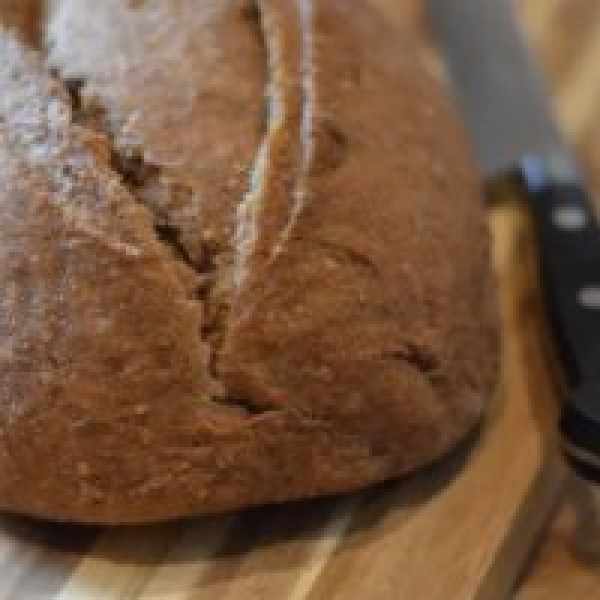
Ingredients:
2 1 / 2 C warm water (100-110 degrees)
1 packet or 1 T yeast (regular or quick rise)
Option: 2 T oil or melted butter
1 T brown sugar, honey or other sweetener
6 C flour (A good combination is 2 1 / 2 whole wheat and 3 1 / 2 white. You may use a combination of whole wheat, white whole wheat, all-purpose white flour or bread flour. You may substitute I C wheat germ or flax seed meal for 1 C whole wheat flour. If adding wheat germ or flax meal, add it with the yeast so that these heavier flours can soften as yeast activates.)
1 T salt
Procedure:
- Sprinkle yeast onto water. Stir or whisk to wet yeast granules completely. Mix sweetener and oil, if using into the wet ingredients until dissolved. Let this stand about 10 minutes as yeast activates. Gather and/or measure other ingredients. Grease your pans by thoroughly brushing with olive or vegetable oil or spray with non-stick cooking spray.
- Stir the dry ingredients into the wet ingredients gradually to make a soft, sticky dough, adding the salt toward the end.
- Turn dough onto a lightly floured surface for kneading. Adjust amount of flour so that dough does not feel water – logged or runny. If it feels too stiff and you feel strain in your fingers as you knead, add a sprinkle of water. Knead about 10 – 20 minutes until dough loses its wet quality and you can see specks of bran against a lighter dough. It might still be a bit sticky.
- Clean the bowl and oil it lightly. Shape the dough into a smooth ball and put it in the bowl. Move it around in the bowl to collect some oil and then turn it over. Cover the bowl with plastic wrap or a dry towel. Be sure there is enough room for the dough to double. Keep bowl in a warm, draft-free place until doubled, about 30 – 45 minutes, up to an hour, as time allows. This develops flavor as well as lift.
- When dough is doubled, you may give it a 2nd rise, if time allows. This means deflate the dough, form it into a ball, return to bowl and cover for another 45 minutes. You can skip the 2nd rise and form the dough into loaves.
- Divide dough into 2 large or 3 small loaves. Squeeze out any air and shape or roll tightly into loaves, placing them each in a greased pan, seam side down. Cover and let rise again, until dough rises to just above the top of the pan, about 30 minutes. Slit the loaf in several places with a sharp knife or razor to let air escape in the over. This can be done once diagonally across the length of the loaf or several times diagonally across its width. Bake at 375 degrees about 25 – 35 minutes or until internal temperature of loaf is about 185-190 degrees. This is a time when a meat thermometer comes in handy! Insert it into the bottom of the loaf. OR, take the loaf out of the pan and tap it on the bottom. If it sounds hollow, it is probably done baking.
If you would like to be notified when we share new recipes, be sure to scroll to the bottom, provide your email address, check the box confirming you are not a robot, click on a few photos to prove it and click subscribe! You will then receive an email after each new post. Remember, we're always looking for new recipes, so keep sending them to ecopact@fspa.org!
Story:
This Easter Week or during the 50-day Easter season, let the Holy One feed your deepest hungers. Even make bread with this recipe for Basic Whole Wheat Bread. Consider how you give bread - material and spiritual - to the hungry. Live the Eucharist and pray "Holy God, give bread to the hungry and hunger for You to those who have bread."
As a follow up to last week's post on food pantries and food insecurity, consider how in the Easter season, you might develop a practice that feeds the hungry and your own hunger for God. After all, the 50 days of the season give us time to develop and maintain a new practice as much as Lent is meant to do! Let your inner voice tell you more about what is yours to do spiritually, materially for the good of the world.
This might mean adopting a food pantry and making a monthly donation of food. Or, if you save on groceries by foregoing a food indulgence, cooking from scratch or meatless more often, tally up the savings and add your local pantry to a monthly charitable giving practice. The season (which includes Earth Day on April 22) might inspire loving the earth through a practice that has been calling to you: gardening, recycling, reusing, reducing waste or writing to your elected official about your love of the earth and all her human and other-than-human creatures.
Canned Tomatoes and Beans, Part I of "The Healing Secrets of Food"
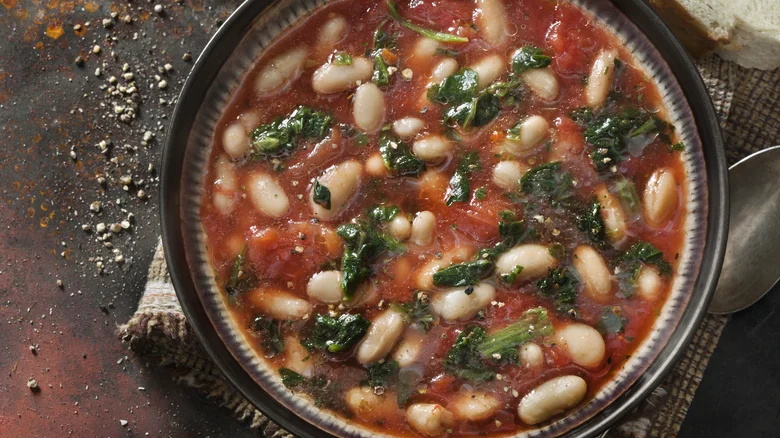
Italian Tomatoes and Beans
Ingredients:
1 T olive oil
1 medium onion, diced
½ tsp Italian spice blend or fresh Italian herbs of your choice (basil, parsley, oregano, garlic)
1 14 oz. cannellini white beans
1 14 oz. can whole tomatoes
Salt and black pepper to taste
8 oz. fresh or grated mozzarella
Serve plain or with crusty bread
Instructions:
Preheat oven to 350 degrees.
To a Dutch oven or cast-iron skillet, add oil and diced onion, if using. Saute on medium heat until onion is translucent, stirring often.
Add garlic (if using) and saute for about 1 minute, stirring as it cooks.
Add spices and/or herbs in the recipe and allow the flavors to “bloom” for about 1 minute.
Add canned ingredients and cook on medium heat until warmed, about 5-10 minutes.
Taste and adjust seasonings, salt and pepper to your liking.
Top with cheese and bake uncovered for 15 – 20 minutes, until cheese is melted.
Serve as recommended.
Middle Eastern/North African Tomatoes and Beans
Ingredients:
1 T olive or vegetable oil
1 medium onion, diced.
1 clove garlic, finely minced
1/8 tsp cinnamon
1/4 tsp paprika
1/4 tsp turmeric
1/8 tsp ground ginger and/or coriander
1 14 oz. garbanzo beans
1 13 oz can crushed or diced fire-roasted tomatoes
1/4 C raisins, golden or regular
1/2 C chopped green olives
Salt and black pepper to taste
1/4 C crumbled feta cheese
Instructions: (See Instructions for Italian Tomatoes and Beans above.)
Mexican Tomatoes and Beans
Ingredients:
1 T vegetable oil
1 T taco seasoning or to taste
1 14 oz can Ro-Tel canned tomatoes and green chilies
1 14 oz can black beans, drained and rinsed.
1 can whole kernel corn, drained and rinsed.
Salt and black pepper to taste
6-8 oz shredded Oaxacan, Monterrey Jack or cheddar cheese
Serve with fresh tortillas, on a bed of corn chips or rice
Instructions: (See Instructions for Italian Tomatoes and Beans above.)
Story:
Canned Tomatoes and Beans can become a delicious, quick and simple meal. Here are 3 variations of the Italian version pictured above on The Tasting Table website. Use ingredients from your pantry in whatever flavors you like best!
Even the most basic of meals can nourish the Body, Mind and Soul. This post is the first of a series of reflections on “The Healing Secrets of Food”. I find them to express many values held by Franciscans!
Food can be a source of stress when we can’t afford to eat well, when we find ourselves eating too much, too fast or without meaning. Sometimes we may feel hungry for loving people with whom to break bread and share our lives.
The first Healing Secret of Food that nutrition researcher Deborah Kesten shares in her book, celebrates how we unite with others through food. This may be common sense to community-minded Franciscans who celebrate often around food, but connecting over meals deserves a closer look at this time of year.
Eating is a social activity. Do I focus on my plate only or on what “flavors” and gifts that others bring to the gathering? How can I center myself in preparation for mealtime to foster more awareness of my table mates? In our diversity of ages, likes and opinions, how can conversation connect us with common memories and common values? Do I listen well, ask questions, and share stories that show I care? How is the food we share, simple or elaborate as it may be, an opportunity for communion?
Some of Jesus’ most memorable words and actions happened as people came together to be fed. Kesten invites us to slow down. We can be nourished by a focus on relationships and community that can heal our incompleteness, lessen our sorrows and unite us in community. Eating alone or with strangers can be meaningful as we acknowledge those with whom we share our common humanity in the presence of the Divine.
Native Americans are returning to the wisdom of working together to provide food for the whole community. An article in the Milwaukee Journal Sentinel describes practices that connect the community to one another and to the land. Planting together, a communal harvest and drying of native corn, wild rice and game remind us of the interdependence the human family can have around feeding one another physically, socially and spiritually.
'Massaged" Kale Salad with Lemon Dressing
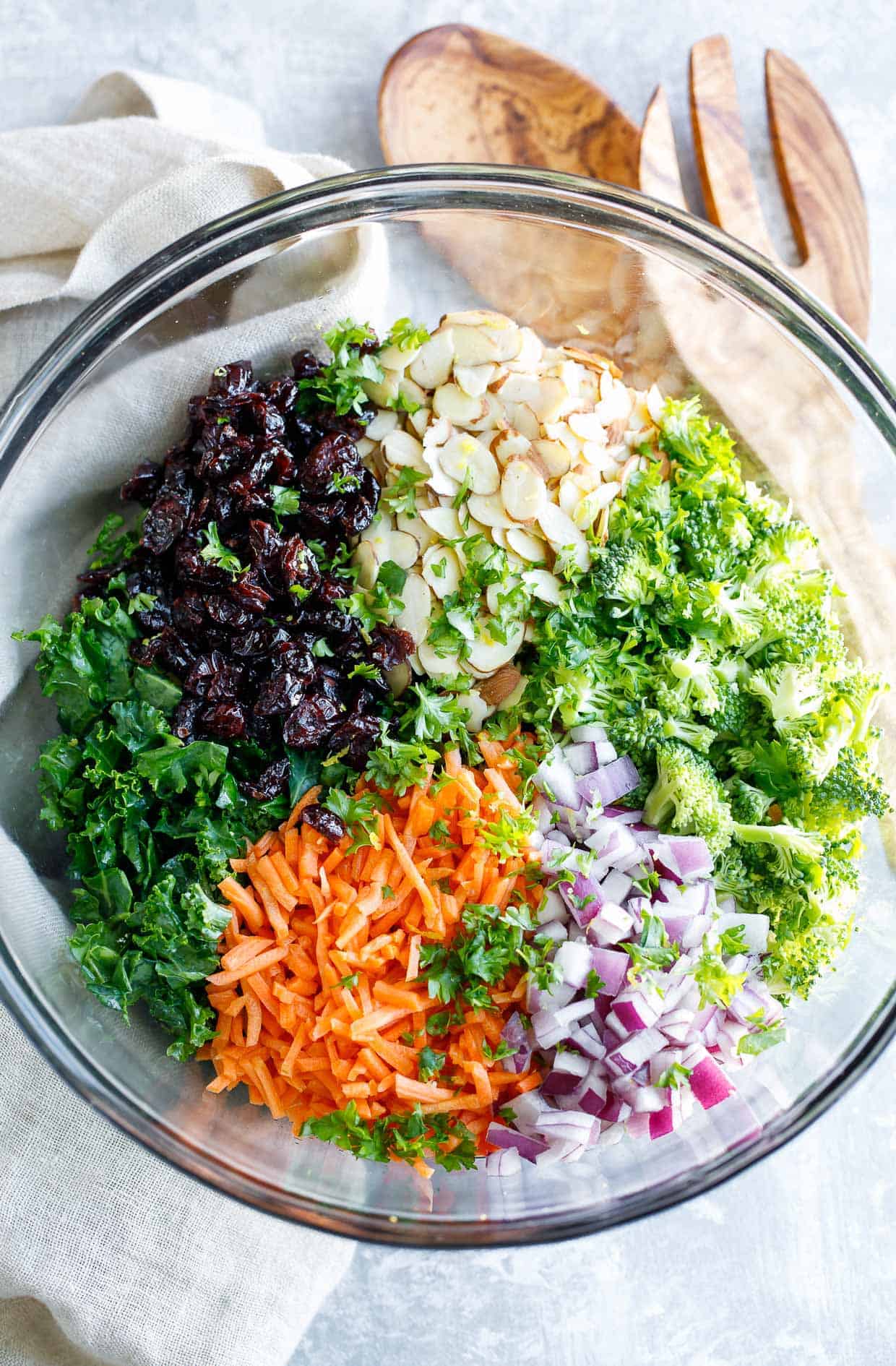
Ingredients:
Dressing:
¼ C olive oil
2 T fresh lemon juice, fresh is best
2 T red wine or other vinegar
1 T Dijon mustard
1 clove garlic, minced
¼ tsp salt
½ tsp dried oregano
1/8 tsp ground black pepper
1 tsp honey or sugar
Salad: 5 C kale chopped or torn into 1' bite-sized pieces
1-2 tsp olive oil
1/8 tsp salt
Optional Additions:
2 C broccoli chopped
½ C nuts: sunflower seeds, sliced almonds, or chopped walnuts
¼ - ½ C shredded carrots or radishes
½ C chopped or shredded apple
¼ C sliced scallions or red onions
¼ C raisins or dried cranberries
½ C cheese (cheddar pieces or shreds, crumbled Feta, parmesan or other favorite)
Leftover cooked chicken or bacon pieces
Your favorite leftover cooked grain: wild rice, quinoa, bulgar, brown rice
croutons
Instructions:
1.Combine dressing ingredients in a lidded jar or bowl. Shake or whisk well to combine. Dip a piece of kale in the dressing. Taste and adjust sweetener, salt, and pepper as you like.
2.Rinse kale leaves in cool water. With one hand, hold on to the thick stem at the end and with the other hand, strip the leaves from the stem. Compost stems or store in water to saute in a few days with spices!
3. Tear or chop dried kale into bit-sized pieces. Spin it dry in a salad spinner OR shake dry and place in a dry kitchen towel. Massage the chopped kale with a little olive oil and a pinch of salt. Rub with your fingers until leaves look darker in color.
4.In a large bowl, combine salad ingredients. Stir or shake the dressing once more. Pour about ? of the dressing on the salad. Toss. Add extra dressing, as you like. There should not be dressing “pooled” in the bottom of the bowl.
Preparing Kale:
Rinse kale leaves in cool water to remove all the dirt and dust.
Hold on to the thick stem end and with the other hand, strip the leaves from the stem. Discard the stems OR put in a tall container with a small amount of water and keep refrigerated to chop and saute a day or two later.
Tear or chop the dried kale into 1 inch (bite-sized) pieces.
Spin it dry in a salad spinner OR shake dry and place in a dry kitchen towel. Fold in the ends of the towel and hold tightly while you spin the whole thing. The towel will absorb most of the water.
(Optional) For a more tender raw kale salad, massage the chopped kale with a little olive oil or lemon juice and a pinch of salt. Rub with your fingers until leaves look a bit darker in color. It really makes a difference and kids love "massaging" the greens".
Story:
This recipe for “’Massaged’ Kale Salad with Lemon Dressing” is full of nutrients, packed with flavor and may make you into a kale lover. Even kids liked it! It can be made ahead as the hardy leaves keep well, even with dressing.
Another recipes made with grade schoolers, it was also demonstrated with younger kids at a local school garden. They got their hands in the bowl to massage the greens! Helping kids of all ages grow and/or prepare vegetables and fruit encourages openness to new foods. Don't we all enjoy getting some coaching in the garden or the kitchen? If you are curious about a certain food or cuisine, baking bread or fixing your favorite restaurant dish, find someone to "coach" you, even if it's an online cook or a TV chef.
The recipe and photo above come from Holly, a Canadian mom of 4 who loves to add to her site called "Spend with Pennies". She suggests we check out how versatile kale can be, saying, "Leftover kale can be stirred into pasta, blended into pesto, and even baked into crispy kale chips, if the craving strikes! The possibilities are endless. I even love a little kale on my pizza when I have it handy." Holly's other kale recipes include kale with rice, Mexican kale salad, kale pesto, kale chips, kale and sausage soup, and kale mango smoothies.
Speaking of smoothies, I put blanched kale in a high speed blender with a touch of vanilla and cinnamon. I added blanched seasonal produce like squash, apples, carrots or pears for baby/toddler food my grandkids liked.
"Too Many Tomatoes" : Tips for Eating and Preserving
“Too Many Tomatoes” Tips for Eating and Preserving
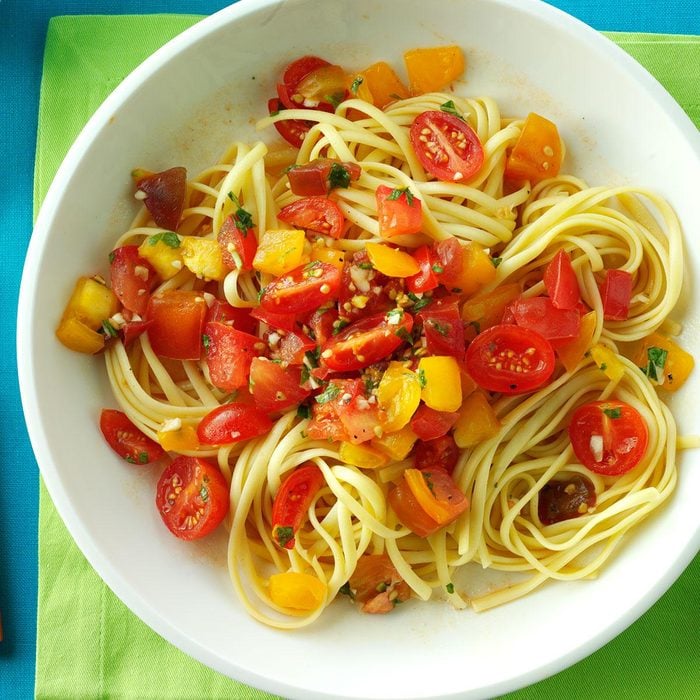
Raw Summer Tomato Sauce by Lidia Bastianich
Ingredients:
1 pound ripe summer tomatoes, at room temperature
1 to 2 plump peeled, finely minced garlic cloves
1/4 tsp salt
3 large basil leaves (about 1 heaping T shredded)
1/8 teaspoon pepperoncino (dried chili flakes), or more or less to taste
1/4 C extra-virgin olive oil
½ C or more grated Parmesan
Directions:
Rinse tomatoes, drain and wipe dry. Cut out the core and any other tough parts.
Working over a big mixing bowl to catch the juices, cut the tomatoes—cherry tomatoes in half; regular tomatoes into 1-inch chunks—and drop them in the bowl.
Smash the garlic cloves with a chef’s knife and chop into a fine paste (easier if you add some of the salt as you chop; mash the garlic bits and salt with the flat side of the knife too.)
Scatter the garlic paste and the rest of the salt (1/ teaspoon in all) over the tomatoes and stir gently.
Pile up the basil leaves and cut into thin strips. Scatter these over the tomatoes, then sprinkle in the pepperoncino.
Pour in the oil, stir and fold to coat the tomatoes and distribute the seasonings.
Cover the bowl with plastic wrap and let it marinate at room temperature for 1 - 2 hours.
Foe Pasta: Toss the marinated sauce with freshly cooked and drained pasta. Top with 1/4 cup grated Parmigiano-Reggiano (aka Parmesan) cheese.
For Pizza: Spread on your favorite uncooked pizza crust, add toppings. Bake at 425 for 15-18 minutes.
For Bruschetta: Place on slices of toasted bread, topped with grated mozzarella & broil until cheese melts.
Caprese Salad: Slice tomatoes and slices of fresh mozzarella cheese. Arrange alternately on a plate. Drizzle with either pesto, flavored olive oil and/or fresh basil leaves whole or in strips. Can also be made with halved cherries tomatoes, stirred into small balls of fresh mozzarella and a bit of basil, as above.
Tomato and Cucumber Salad: Slice tomatoes, cucumbers, and onion. Cut slices in half if your veggies are large. Place in a bowl or arrange on a plate. Add your favorite Italian Dressing or Italian seasonings, vinegar, oil, salt and pepper. Can also add sliced green pepper! Let stand for at least 30 minutes to let flavors penetrate the vegetables.
Oven-Roasted Tomatoes: On a parchment paper lined baking sheet, place sliced tomatoes (Roma or Amish Paste are perfect) and drizzle with your favorite oil and seasonings. Roast in a low 175 degree oven, until tomatoes are somewhat dry roasted, but not burned. Check every 30 minutes or so. Can be spread on bread, used as a pasta/pizza sauce, frozen or canned.
Crock-Pot Spaghetti Sauce: Wash and core your tomatoes. Peeling is optional. (See below). Fill any size crock pot to the rim and add olive oil and your favorite Spaghetti Sauce seasonings, such as salt, pepper, red chili flakes, basil, oregano, fresh or powdered garlic, bay leaves. Cook on high for 4 hours or on low overnight until tomatoes are very soft. Stir as often as you can to prevent sticking.
Use an immersion blender or a high power upright blender blend to break up seeds, skins and flesh in batches. If tomato mixture is still hot, fill upright blender only about half full so heat does not build up too. A food processor will also work, but some seeds/skin may remain.
Can or freeze sauce as to your preference.
How to Peel Tomatoes by Blanching
The Food Network advises that we avoid using a vegetable peeler to peel your tomatoes, as it will remove part of the tomato flesh along with the skin. The most efficient way to peel tomatoes is to blanch the tomatoes by quickly boiling them in hot water, which helps to loosen the skin from the flesh, and then shock them in an ice bath.
Add tomatoes to boiling water for 20 to 30 seconds until the skin begins to wrinkle and peel away from the flesh. Don't let the tomatoes sit too long in the water, or they will start to cook. Using a slotted spoon or a strainer, strain the tomatoes and transfer them to the bowl of ice water to cool.
How to Peel Tomatoes In the Microwave
If you don’t have time to boil a pot of water to blanch your tomatoes, or if you just need to peel one or two tomatoes, try microwaving them.
Wash and dry the tomatoes and remove any stems. Use a paring knife to cut a small, shallow X on the bottom of each tomato (the opposite end to the stem end).
Place 1 to 2 tomatoes in a microwave safe container and microwave on high for 25 to 30 seconds. Keep a close watch as the tomatoes could explode.
Let tomatoes cool before handling (or shock them in an ice bath to speed up the process). The skins will slip right off with the aid of a paring knife.
Dried Tomato Powder
Ingredients:
Skins from about 10 tomatoes (See above for how to skin tomatoes)
Instructions: Peel skin and place the tomato skin on a parchment lined baking sheet. Set the tomatoes aside to use later or make homemade tomato salsa or sauce.
Bake tomato skins at 190°F for 3-4 hours in total. You can also use a convection setting. This will cause tomato skins to dry faster but be sure to check throughout the baking process to avoid burning.
After one hour of baking, turn tomato skins over and continue to bake for another hour. Turn tomato skins over again and bake for another 1-2 hours until they're completely dry but not burnt.
After the skins have cooled, grind them with a coffee grinder, a food processor, blender or mortar and pestle until a fine powder is formed.
Place the ground tomato powder in a clean, dry jar with a lid and place in the fridge or counter top for later use. Dried powder should last up to a year in a sealed jar.
Tomato Powder From Microwaved Tomato Skins by Niki Achitoff-Gray of Serious Eats
Ingredients:
Skins from 10 peeled tomatoes
1/4 teaspoon kosher salt
1/4 teaspoon granulated sugar (optional)
Directions:
Line a microwave-safe plate with a double layer of paper towels. Spread as many tomato skins on top as will fit in a single, non-overlapping layer (about 1/4 of skins). Microwave on high for 4 minutes, then continue in 20-second intervals until the skins are papery, dry, and crumble if pinched. Repeat with remaining skins.
Add skins, salt, and sugar (if using) to spice grinder, food processor or mortar and pestle. Grind until powdered. Store in an air-tight container.
If you would like to be notified when we share new recipes, be sure to scroll to the bottom, provide your email address, check the box confirming you are not a robot, click on a few photos to prove it and click subscribe! You will then receive an email after each new post. Remember, we're always looking for new recipes, so keep sending them to ecopact@fspa.org!
Story:
Seasonal eating is never better, in my experience, than when fresh tomatoes come along. We can't take for granted the privilege of gardening and the availability of the water that nourishes that juicy produce. It's fitting that from September 1, World Day of Prayer for the Care of Creation, to October 4th, the feast of St. Francis of Assisi.to October 4 has been named the "Season of Creation". It is a time of dedication to God as Creator and Sustainer of all life. The Season of Creation is an ecumenical celebration that allows all people to recognize ourselves as the work of the God's creative act, to contemplate nature and all that dwells in it, and to care for our Common Home.
“Let Justice and Peace Flow” is the theme chosen for Season of Creation 2023. The prophet Amos cries out, “But let justice roll on like a river, righteousness like a never-failing stream!” (Amos 5: 24), and so we are called to join the river of justice and peace, to take up climate and ecological justice, and to speak out with and for communities most impacted by climate injustice and the loss of biodiversity.
Pope Francis focused on drought in his Sept. 1 message on the World Day of Prayer for Creation. “Our unbridled burning of fossil fuels and destruction of forests are raising temperatures and causing great droughts,” says the Pope. It's important to join with others to address the needs of humanity and of Sister Earth, our Common Home. Learn more about the FSPA commitment to Integral Ecology and the Laudato Si movement. "Praise be to you, my Lord, through our sister mother earth who sustains and governs us and produces various fruits with colored flowers and herbs." Laudato Si
Step boldly into National Vocation Awareness Week!
"Is God calling me to discern religious life as a sister, brother, priest or deacon?"
As we celebrate All Saints and All Souls, we remember that most of humanity has, at one time or another, wrestled with the question “Who am I called to be?” In celebration of National Vocation Awareness Week, Nov. 3 - 9, Show me a sign is inviting you to discern what is perhaps an emerging question: “Is God calling me to discern religious life as a sister, brother, priest or deacon?”
Prayer, conversation, research and action are all important aspects of discerning a vocation. And so we invite you to do just that.
Pray:
We encourage you to pray and talk to God about your vocation. Commit to spending a specific time with God. Write it down. Don’t just think about taking time to pray, make it happen.

Perpetual adoration – round-the-clock prayer that FSPA began in 1878 – is practiced in the St. Rose Convent Perpetual Adoration Chapel in La Crosse, Wisconsin.
Discuss:
Talk with friends or family members you trust about what they see as your gifts and talents and the possibility that religious life could be a wonderful way for you to use them.
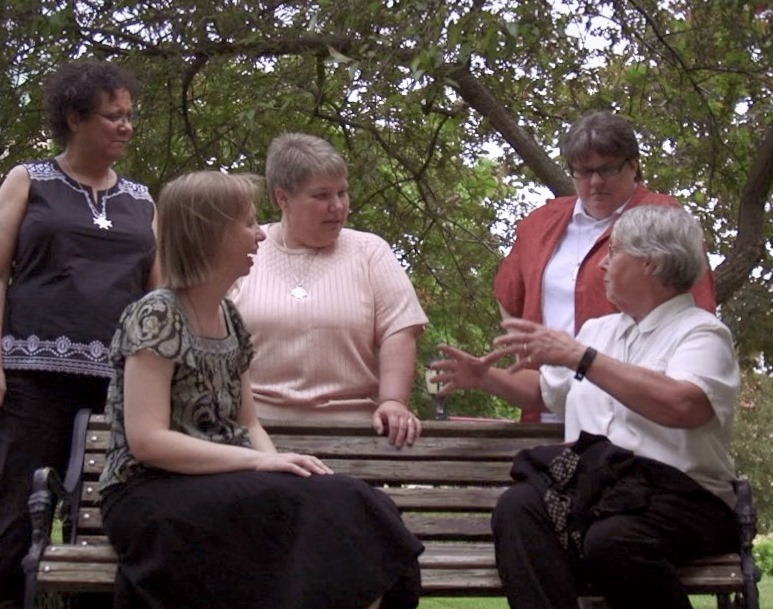
Sisters Jacinta Jackson, Sarah Hennessey, Dawn Kutt, Laura Nettles and Lucy Slinger support each other through discernment and beyond. Image courtesy of Vendi Advertising.
Research:
The internet is a great tool for learning more about religious life. Here are some excellent websites to visit as you begin your journey of discovery. Be aware of the questions that come to your mind as you visit each site:
fspa.org
religiousministries.com
anunslife.org
usccb.org
Take action:
National Vocation Awareness Week is a big opportunity to take a bold step in your discernment by meeting a sister (or a brother, priest, or deacon) and discover how they live their vocation. Communicators for Women Religious is offering several opportunities for you to do just that throughout the week with the #2019 Meet Our Sisters Tour in Chicago, Illinois. Sister Kristin, a Franciscan Sister of Perpetual Adoration, will be at Su Casa Catholic Worker House (5045 S. Laffin St.) this Monday (4:30-7 p.m.), Tuesday (10-11:30 p.m.) and Wednesday (4:30 to 7 p.m.). Stop by to see her, learn more about Su Casa’s mission of hospitality and intentional community, and discover how religious sisters serve a society rooted in simplicity, free of violence, and abounding in love there.
And, stay tuned to Show me a sign as we celebrate National Vocations Awareness Week!
Are you discerning religious life? Walking with someone who is? We invite you to share this link, www.fspa.org/showmeasign, and join the conversation.
Ten Local Food Gift Ideas

Food gifts are good gifts! for friends, for yourself, for the holidays and in the New Year. As my Mom used to say, "This is for me, from one who cares!"
Bakery and Other Specialties in Wisconsin, for example include: Apple Bread from La Crescent, Cherries from Door County, Kringle from Racine, Pasties from Hurley, Pickled Ham Hocks and eggs from Milwaukee, Sausage from Backalars and Pickles, Cheese, Cheese curds and Sausage from almost anywhere! What specialties are in your area?
Berries and Cranberries were harvested by native people who knew their health benefits. Phytochemicals found in berries and other foods with deep color are important in a plant-rich diet. Wisconsin is #1 producer of cranberries in the U.S., growing 59% of the cranberries used for juice, dried cranberries and more! Add some dried "crane" berries to whole grain oat granola or to a pinecone birdfeeder!
Beverages like Sprecher’s Root Beer and specialty sodas, Spotted Cow beer from New Glarus, Apple Cider from almost any Orchard Store like Bauer’s in La Crescent, and, of course fruits of the vine: wines, brews and hard beverages from local wineries, breweries and distilleries. Local people take pride in what they bring to the festivities and to the economy.
CSA (Community Support Agriculture) refers to a partnership between farmers who sell their home grown (often organic) produce, eggs, chicken, pork and more direct to the eaters, who serves as shareholders or subscribers. You pay before the season and begin getting a “share”, a box of food (or a couple of chickens!) at harvest time. Now is the time to consider trying this for next spring and summer! For more information ask around or go to the Know where your food comes from website.
Fish. Smelt in spring, trout in summer and perch through the ice in winter are catches we treasure in the Great Lakes and upper Midwest region. Check out the Red Cliff Fish Company who sell fresh, smoked and frozen fillets of Lake Superior fish. Yum!
Game Meats have always been a northern staple for families that knew how to hunt and prepare these lean proteins. Today, bison has become popular in tribes for its cultural and spiritual value. It is gaining recognition among non-natives as a low cholesterol meat as well as for its contribution to tribal economies. Check for it in your local co-op, small meat market or larger meat departments.
Honey is a healthy locally produced food. If you can’t buy from a farmer, check the label for its origin! Local honey is often given credit for increasing our immunity to common local weeds to which folks have allergies. It tastes great, too!
Local dairy, meats and produce Check out your local Food Co-Op for items sourced from local farmers and cooperatives like Organic Valley in La Farge, WI or Belgioso Cheese in Denmark, WI.
Maple Syrup is a flavorful ingredient that kept native diets calorie and mineral-rich through long winters. Once you taste locally produced maple syrup, you won’t go back to corn syrup with maple flavoring!
Wild Rice adds great nutritional and cultural value to any food gift and can support native tribes who harvest and process this “good berry” or “manoomin”, using traditional ways. Check out Native Harvest Ojibwe Products, a division of White Earth Land Recovery Project. Warming water temps are making the survival of this grass vital to the identity of Ojibwe people in Northern WI and MN. All efforts to reduce global warming will protect this high protein, high fiber spiritual food.
Story:
Locally grown foods have many benefits. The Wisconsin Local Food Organization tells us that they help:
* Develop and strengthen a connection between local farmers, chefs, and eaters
* Awareness about what grows around us
* Highlight personal and environmental benefits
* Put a face, a place and taste to our food
* Get people cooking again and foster healthier eating
* Experience and enjoy incredible food and meals
* Support local small business and their workers
* Keep dollars in the local community
* Help us identify with the land we live on and the culture of food production
Convenience has been a boon to the food industry since after World War II. Our mothers and grandmothers who once cooked from scratched were prime targets of advertising for all things easy from Jello and Swanson TV Dinners to menu items "in a mix" of all the food groups. In processing, fiber and its nutritional value are removed to make grains, for example, more shelf stable. Preservatives, additives, salt, sugar and even gases are added to make them tasty and long lasting for distribution around the country. But today, we can examine that system and get closer to the food and to the land.
Consider a convenience food (like chips, instant potatoes, cake mix, soda pop) that could be made from scratch in your kitchen. How could a natural food like nuts, sweet potatoes, frozen cranberry juice or a homemade baking mix add to your life rather than be an inconvenience. It may be a challenge to address in partnership with a friend or family member.
If you would like to be notified when we share new recipes, be sure to scroll to the bottom, provide your email address, check the box confirming you are not a robot, click on a few photos to prove it and click subscribe! You will then receive an email after each new post. Remember, we're always looking for new recipes, so keep sending them to ecopact@fspa.org!
The Seasoned Franciscan will be on hiatus for the rest of Advent and the Christmas season. Watch for a new post in mid-January!
Merry Christmas! Vicki
Asparagus and Honey Lemon Chicken & Easter Reflections
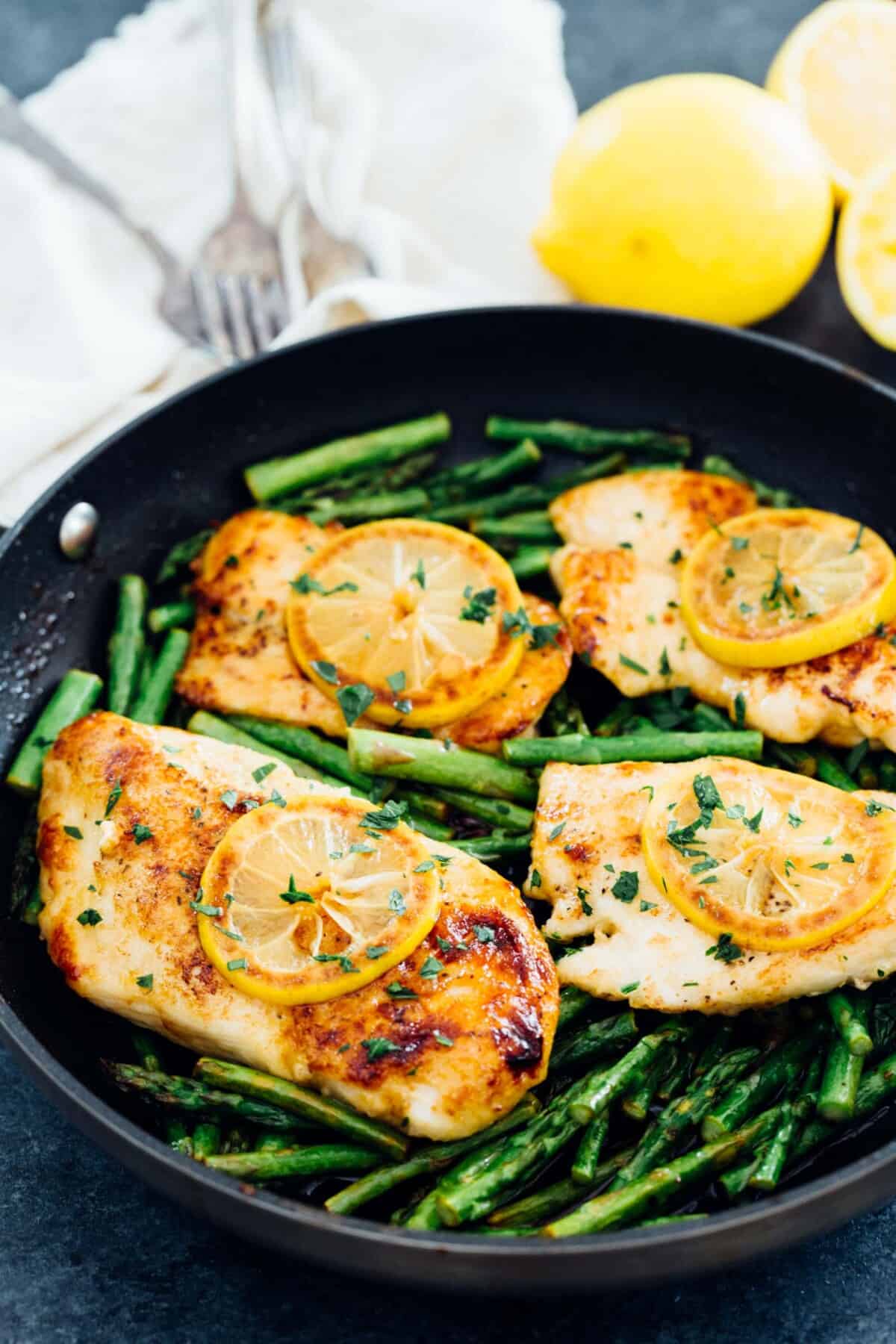
Ingredients:
4 T softened butter, preferably unsalted
2 T honey
juice of 1 lemon, divided
¼ C cornstarch or flour
salt and pepper
1 pound boneless, skinless chicken breasts
large bunch of asparagus, about 3/4 – 1 pound, trimmed*
*To trim asparagus, cut off the bottom inch or two with a knife or simply break it off with your hands. You may also use a vegetable peeler to peel off the tough outer skin of the lower few inches.
Instructions:
In a small bowl, whisk together softened butter, honey, and juice of 1/2 the lemon. Set aside.
In a pie plate, plate or plastic bag, combine cornstarch/flour, salt and pepper. Add chicken and coat it evenly with the seasoned flour. Dust off excess flour.
In a large skillet over medium-high heat, melt honey butter mixture then add the chicken and brown on one side, about 5-7 minutes. Repeat on the other side and cook until chicken has cooked through and internal temperature reaches 165 degrees with a meat thermometer.
Add the asparagus to the skillet and cook until just tender. Squeeze the remainder 1/2 of the lemon onto the cooked dish.
Optional: Slice another lemon and after the chicken and asparagus has finished cooking, "cook" the lemon to use as a garnish as shown in the photo above provided by
For more asparagus ideas, check out the Pioneer Woman's 30 Best Asparagus Recipes to Celebrate the Spring Veggie. Read some Asparagus Facts after the story below!
If you would like to be notified when we share new recipes, be sure to scroll to the bottom, provide your email address, check the box confirming you are not a robot, click on a few photos to prove it and click subscribe! You will then receive an email after each new post. Remember, we're always looking for new recipes, so keep sending them to ecopact@fspa.org!
Story:
This Lent and Easter has led me to pray, read and reflect about individual conversion and service. Saint Francis on his death bed, encouraged us to ask: “What is mine to do?” What communities of service call and guide me to act? I am definitely passionate and active about feeding the hungry. I can cook from scratch, eat seasonally, garden, compost, help end food insecurity by cooking for unsheltered brothers and sisters, offering to coach people in the kitchen, encouraging donations to Food Pantries and Food Banks. I also know that charity is not enough. When it comes to feeding the hungry, how can I become more of an advocate for systemic change and transformation?
The Resurrection season confirms these questions in me. Jesus’ rising changes everything! No one should be bound by suffering and death. To me, that means one act at a time. It means acting in community with others toward changing systems that condones hunger, war, economic insecurity, racism and environmental injustice. How do we act with others and learn, to see with new eyes, to wake up to what is possible? Below are some resources that encourage me. I'm learning. Let us encourage each other to bring the power of new life, forgiveness and systemic change that lives out the resurrection of Jesus Christ!
Bread for the World an advocacy group for addressing world hunger, tells us advocacy with Congress is valuable, stating: "Federal nutrition programs provide roughly 10 times as much food assistance as private churches and charities combined."
Pax Christi USA an advocacy group for peacemakers shares an April 6th article called Easter calls us to ensure the survival of humanity by Joseph Nagle, OFM. Pax Christi International peace movement website shares how to Pray on Sunday, Act on Monday.
NETWORK Advocates for Justice Inspired by Catholic Sisters, is a ministry well-versed in addressing White Supremacy and other ills that call for healing changes at the national and global level. Their website states: "The Catholic Social Justice principle of participation calls us to inform ourselves about the issues of the day, to engage in serious conversations with our neighbors about our nation’s future, and to learn to listen to different perspectives with empathy. This responsibility to participate means each person must be equipped with the resources needed to do so."
Franciscan Justice Circles, supported by the Franciscan Action Network, offers ways to gather with others near you in person or virtually to work for justice. "Our times need grassroots, Franciscan inspired advocacy and action connecting Franciscan-hearted individuals through prayer, action, and advocacy in cities across the country." There is one called "Driftless Region FSC - Western Wisconsin/SE Minnesota".
Feeding Tomorrow, a documentary by Oliver and Simon English, directly addresses the food system and ways to transform it. Stream it free on Hoopla (an app from many local public libraries) that provides movies to view for free. You can also rent or buy it on Amazon Prime. Read more at FeedingTomorrow, Starting Today. My dream is to gather people from all walks of life to watch the film and later, to gather at round tables to talk about it's impact and actions to take together! More on “Feeding Tomorrow” soon.
Asparagus Facts:
• Asparagus is one of only 3 perennial vegetables that thrive in the upper Midwest, along with rhubarb and horseradish, a yearly reminder of hope and resurrection!
• Asparagus seeds or more developed “crowns” take 2-3 years to produce fruit. Patience, trust and care, gardeners! It can even be sown in pastures and harvested from among the forage plants.
• The edible stems or “spears” arise from underground. Asparagus season lasts about 6-8 weeks, early May to late June in MN and WI, so corresponds to spring and even the Easter season most years! After that, we let the leaves in the form of beautiful “ferns” grow to strengthen the plant for the next cycle of new life. Even the ferns require some care to flourish. Info above courtesy of University of Minnesota Extension.
• In summer, fall and winter through April, some fresh asparagus at most stores is from CA, but most is from Mexico or Peru. This trend is tied to rising water prices in the US, the passage of NAFTA, and the unintended effects of the US War on Drugs. Boston Organics tells us that Peruvian farmers who once grew coca for cocaine were subsidized by the U.S to switch to asparagus. Soon Del Monte moved its processing plant there to take advantage of lower prices.
• Soon fresh, tasty local spears can be found at your favorite farmer’s market or co-op..
• Seasonal eaters don’t shy away from sort of “gorging” on seasonal asparagus. It can be roasted, blanched, pan seared, added to soup, risotto, pasta dishes, an open face egg or ham sandwich, quiche or served as an appetizer wrapped in bacon or Italian ham. The recipe below is a one skillet meal with a built-in side of asparagus! What is your favorite spring vegetable recipe to repeat while it is in season?
Step boldly into vocation: Giving Voice
Sharing Gospel living and the desire to "Live Religious Life NOW!"
Nearly 80 women of over 40 congregations, including several FSPA, came together for the 2019 National Giving Voice Gathering (image courtesy of Sophie Vodvarka).
Religious life is a vibrant and wonderful way to further the mission of the Gospel — just one of the reasons to celebrate as we honor National Vocation Awareness Week, Nov. 3 - 9. Today, I am living out this ministry as a member of the FSPA community — vowed Franciscan women centered in Eucharist, committed to be loving presence through prayer, witness and service.
I am also sharing Gospel living with other women religious from around the world through my association with Giving Voice, a peer-led organization of religious women under the age of 50. Sisters gather from all different congregations to share in the joy of religious life and the many ways it flourishes around out world. They recently came together to celebrate — to “Live Religious Life NOW!” — and created this video to share their experience:
Watch it and ask yourself: Are you called to add your voice to the conversation of religious life?
National Vocation Awareness Week is a big opportunity to take a bold step in your discernment by meeting a sister (or a brother, priest, or deacon) and discover how they live their vocation. Communicators for Women Religious is offering several opportunities for you to do just that throughout the week with the #2019 Meet Our Sisters Tour in Chicago, Illinois. Sister Kristin, a Franciscan Sister of Perpetual Adoration, will be at Su Casa Catholic Worker House (5045 S. Laffin St., Chicago) today from 10-11:30 p.m. and Wednesday from 4:30 to 7 p.m. Stop by to see her, learn more about Su Casa’s mission of hospitality and intentional community, and discover how religious sisters serve a society rooted in simplicity, free of violence, and abounding in love there.
And, stay tuned to Show me a sign as we continue to celebrate National Vocation Awareness Week!
Are you discerning religious life? Walking with someone who is? We invite you to share this link, www.fspa.org/showmeasign, and join the conversation.
Intuition: an essential tool for home improvement and discernment
To me, do-it-yourself home improvement projects always sound simple and I typically imagine completing whatever the task in a short amount of time; achieving the perfect final product. My calculations are definitely hit and miss. This past weekend’s to-do was hanging new curtains, both homey and specific the needs of preserving warmth and saving energy. With all of the necessary supplies on hand we began by reading the instructions for installing the decorative curtain rod. Just four “easy steps” were listed in tiny text with an accompanying diagram.
After marking the wall and pre-drilling holes for the brackets we were excited to see quick progress, yet it soon came to a grinding halt with simultaneous mutterings of “What do you mean it doesn’t fit?” and “The directions don’t say anything about what to do if only one side of the extension rod fits.” Ha … so much for four simple steps and the promise that all required was included. Maybe we should have called in a professional!
Finally, we took a moment to pause and breathe (and laugh a little); tossed aside the directions and shared ideas. Within five minutes, by drawing from intuition where the directions failed, the new curtains were hung (perfectly straight!) with care. It was truly a do-it-ourselves project.

Image courtesy of pixabay.com
The experience was a great reminder that there might not be specific instructions to complete the perfect household project or for building the future, discernment included. When the details of discerning religious life don’t fit exactly into your life as you think they should, simple tools like breathing and pausing and allowing time to find your own direction are essential. The article “Do-it-yourself discernment retreat” published in “VISION Vocation Network” offers a Sunday-through-Saturday guide (like “Don’t leave it to the experts”) with simple steps to help you learn invaluable cross-over skills, to blaze your own trails and build experiences to religious life.
This week, I invite you to think of the ways you’ve used the skills of discernment in your everyday context of life.
What happened when you relaxed and thought outside the box?
*Do you know someone experiencing discernment of religious life? We invite you to share this link, www.fspa.org/showmeasign, and join the conversation.
Mulled Apple Cider
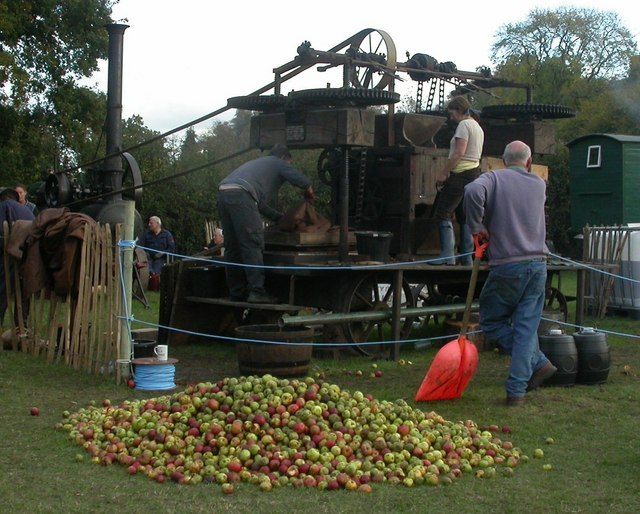
Ingredients:
1 whole nutmeg
10 allspice berries
10 cloves
2 star anise
4 cinnamon sticks
½ gallon apple cider
¼ cup rum, optional
1 small orange, for garnish
Whole cranberries for garnish
Note: The recipe doubles easily, and fits into a standard slow cooker or Instant Pot.
Instructions:
Toast the spices first. Add the nutmeg, allspice, cloves, star anise and cinnamon to the bottom of a pot or skillet. Toast over medium heat for 2 to 3 minutes, stirring occasionally, until fragrant.
Stovetop Instructions: Turn the heat to low. Pour in the apple cider and bring to below a simmer, just barely bubbling. Warm for 1 - 3 hours on low heat (don’t let it simmer). Some brands of apple cider have some particulate in the bottom of the jug. This is completely expected. Strain or skim off any particulate, if desired, or stir to re-incorporate it.
Slow Cooker & Instant Pot Instructions: Place the apple cider in the slow cooker or Instant Pot (pressure cooker) with the toasted spices. Cook on low for 1-3 hours OR use the Instant Pot “Slow Cooker” setting.
Garnish last. If you cook mulled cider with fruit like orange slices and apple slices, they’ll fall to the bottom and the color will fade. Instead, use them as a garnish after cooking.
If using rum, stir it in at the end. The rum adds a bit of warmth and takes mulled cider to another level. If you’re serving a party where not everyone is drinking, you could also leave out the rum and let guests add a splash to their own drinks. The recommendation is to add only ½ T of rum per glass.
For more Hot Drinks, check out these ideas from Sonja and Alex:
Mulled Wine: Simmer red wine with orange zest, cloves, cinnamon sticks, allspice, brandy and honey.
Homemade Hot ChocolateThere’s no need for a packaged mix if you’re craving hot cocoa!
Spiked Hot Chocolate: On cool evenings in fall or anytime in ski country, hot chocolate can also be “spiked” with: a teaspoon of Peppermint Schnapps or Creme De Menthe, Baileys Irish Creme, or Kahlua
Caution: Don’t imbibe alcohol if you will be spending lots of time outdoors. The alcohol makes your body feel warmer than the air temperature indicates.
If you would like to be notified when we share new recipes, be sure to scroll to the bottom, provide your email address, check the box confirming you are not a robot, click on a few photos to prove it and click subscribe! You will then receive an email after each new post. Remember, we're always looking for new recipes, so keep sending them to ecopact@fspa.org!
Story:
To “mull,” apple cider or red wine means “to heat, sweeten, and flavor it with whole spices”. ”Mulled cider is a cozy drink during fall apple season! Infused with spices like cinnamon and nutmeg or cloves, it will lift your spirits and make your kitchen smell like fall. Smells can hold memories, so as hands are clasped around warm mugs, memories can be shared and made.
The flavor of apple cider is crisp. But after simmering with mulling spices (whole cloves, cinnamon sticks, allspice berries, a nutmeg berry or “nut” and star anise), the flavor blossoms into something warm and spiced. Dried and ground spices would make the drink cloudy. Mulled drinks can be made in a slow cooker or on the stove. Using whole spices infuses the entire drink (and your home) with that warm flavor and scent.
Today, the United Kingdom and United States are the biggest producers of cider in the world. Yet, at some point in the last few hundred years, the words “apple cider” have evolved to mean different things in these two nations. To understand the difference between “cyder” and “cider”, we need a little history.
Some Apple Cider History:
• People have been making apple cider for thousands of years, using wild apples that grew in the ancient British Isles. Some evidence shows that the Celts drank a cruder form of crab apple cider, as far back as 3,000 BCE.
• Once they invaded the British Isles, the Romans encouraged apple cultivation for fermented cider, although wine was their more “civilized” preference.
• When Christian monks established monasteries in Europe, they also fermented cider where apples grew.
• When European settlers traveled to North America, they took fermented cider with them.
• In colonial America, cider was the most commonly produced drink—the beverage of choice for most Americans. It was a time when imbibing water was questionable due to the potential presence of disease-causing organisms. Then, cider was a fermented product usually between 4-6% alcohol.
• New England residents in the 18th century consumed cider generously: an estimated 15 to 54 gallons per year.
• As European settlers moved west into the newly acquired Northwest Territory (Illinois, Indiana, Michigan, Ohio, and Wisconsin) they planted apples, in part to prove their commitment to their new homes. Enter the legendary Johnny Appleseed (John Chapman). Eventually, the process of grafting trees was preferred to planting seeds.
• The Industrial Revolution saw the immigration of much needed laborers increase. This new wave of settlers created a taste for beer and hard liquor. Barley and other grains could be grown as settlers moved west.
• World War I made grains less available for producing alcoholic beverages. Negative sentiments toward Germans and their beer industry also lowered production of beer.
• In 1920, prohibition halted the production of beer and hard beverages. Interestingly, farmers could make limited quantities of naturally-fermented products, so long as they were “not meant to intoxicate.” So, what was a farmer to do?
• During the prohibition era, some orchards of heirloom apple varieties were burned down by the FBI and overzealous supporters of the temperance movement.
• Due to suspicion of all things alcoholic, the cider industry in the United States turned to growing sweeter eating apples and “sweet cider” became synonymous with fall and farm life.
• In the American state of New Hampshire, the state beverage of apple cider is like unfiltered apple juice. But in the famed cider-growing regions in Britain, France and in Spain, cider remains a fermented, alcoholic beverage.
• Today, the popularity of “hard” or fermented cider is gaining popularity. This cider often includes astringent, tannin-rich apples to create interesting, full-bodied, dry ciders.
• The hot, mulled beverage Americans know and love is usually made from culinary apples, such as Jonagold, Honeycrisp, and Gala. The final product for both sweet and hard ciders is usually pasteurized or UV-sterilized.
Some of these history facts and the photo above come from Gastro Obscura, which covers all sorts of issues about the world’s most wondrous food and drink.
Sister Amy's 6 Word Story of Hope
Discerning action, spreading strength in times of great need
Hope is more than a word: it is an invisible, nutrient-dense reservoir of strength, resiliency and creativity. Hope holds the dichotomy of present unrest and future peace. It is the hardy root of our prayer reaching deep into relationship with God who helps to nourish the brave new tendrils of growth. Sharing hope with one another germinates new possibilities. The winds of collaboration carry the precious, newly-formed seeds to new places, transforming the landscape of our world.
This Show me a sign blog post is the first in the new series "6 Word Stories of Hope" that features inspiration shared by many Franciscan Sisters of Perpetual Adoration. Their stories reflect FSPA's mission and vision, "prayer, witness and service," so critical to us all in this time of uncertainty.
We invite you to take their words of wisdom with you as you face each new day, opening yourself to new possibilities.
And perhaps these 6 Word Stories will enlighten you to discernment of religious life.
Stay tuned for more Show me a sign 6 Word Stories.
Are you discerning religious life? Walking with someone who is? We invite you to share this link, fspa.org/showmeasign, and join the conversation.
A Revolution of Goodness has begun
They gathered, gloriously, around goodness. They weren’t classified as sisters, affiliates and guests but as equal discerners of goodness. They weren’t segregated as individual observers...
Sister Beth: "Pay attention to your dreams and desires."
"I love companioning people as they live into the fullness of God's invitation for their lives."

FSPA Golden Jubilarian Beth Saner, celebrating 50 years of vowed religious life
“The direction for your life,” says Franciscan Sister of Perpetual Adoration Beth Saner, “may be hiding in plain sight.” In celebration of her golden jubilee — 50 years of living vowed religious life, engaged in furthering the work of the Gospel and the Catholic church — Show me a sign shares some of Sister Beth’s soul-searching discernment story and the wisdom she offers to those beginning their own.
Show me a sign:
How did you know that you wanted to be a sister?
Sister Beth:
I didn’t really 'know.' My best friend and I decided we would become sisters when we were 11 years old, probably because we were fascinated by the sisters we knew; their lives seemed so mysterious. We never really talked much about it after that until we were high school seniors. She went to college intending to study medicine, and I chose to go to the convent.
Show me a sign:
How did your family and friends react when you first told them of your desire to live religious life?
Sister Beth:
I encountered mixed reactions. My mother was adamantly opposed, while my dad was quietly supportive. Everyone else was noncommittal. I didn’t say much to my friends until it was time to go but when I told them, they were supportive.
Show me a sign:
As you reflect on your jubilee, what facets of serving as an FSPA first come to mind?
Sister Beth:
After 50 years, here are a few:
- As a young religious, I was always energized and enthusiastic about the way religious life was evolving in response to Vatican II.
- I’ve found that community life is not always easy, but living, working and praying in community has been a rich and personally fulfilling experience for me.
- Opportunities for on-going education, both formal and informal, all for the sake of FSPA mission, are true gift.
Sister Beth (left), a member of the FSPA Incorporation Team, rejoices in the moment that Sister Michelle Petitt (right) becomes a novice.
Show me a sign:
What has been your favorite ministry, and why?
Sister Beth:
I’m lucky to have ministered in areas of my choice and that utilize my gifts and talents. I have loved my life of service, first as a teacher and liturgist at Viterbo University and then as a spiritual director and instructor in Chicago. I love companioning people as they live into the fullness of God’s invitation for their lives. That happened for me, both as a teacher and now as a spiritual companion.
Show me a sign:
What advice would you give women discerning religious life today?
Sister Beth:
Pay attention to your dreams and desires. The direction for your life may be hiding there in plain sight.
Are you discerning religious life? Walking with someone who is? We invite you to share this link, www.fspa.org/showmeasign, and join the conversation.
Life as a nun today: FSPA can relate
Sharing your desire to be a sister with family and friends can be challenging, especially if they only envision their teacher — wearing a habit — standing at the head of the class before the late 1960s after Vatican II when many religious communities chose to wear everyday clothing more reflective of modern times? “Refinery 29” recently published the article “What Convent Life Is Really Like In 2017,” and Show me a sign invites you to share the conversation with those around you who don’t necessarily understand what it means to live religious life — in life style and ministry — today.

Sister Winifred teaching at Aquinas High School in her habit

Sister Laura teaching at Viterbo University today
"As is often the case with mainstream religions," begins the article in which Sisters of St. Joseph Karen Burke speaks to "faith, service and living as a nun," "misconceptions about sisters and their congregations abound."
First introductions often spark confusion as she says she hears, "'Oh, sisters don’t wear habits anymore?' or some other remark on her everyday outfit of jeans and a sweatshirt. While women in other orders may choose to wear a full habit, many congregations no long require it, the Sisters of St. Joseph included."
As Sister Sarah shares, we can relate.
"Sister Karen tells us that the Sisters of St. Joseph has always worked in the fields of education and health care, but in the past few years they've concerned themselves with, of all things, environmentalism ..."
As Sister Lucy ministers, we can relate.
"Sister Karen describes her decision to leave her career as an educator as a "leap of faith," adding that it surely won't be her last. "Through my own faith and through my own prayer and spirituality, my life will continue to change."
As Show me a sign recently explored career changes as a Catholic sister, we can relate.
Amidst changes in religious life and the growing needs in our world one constant is sisters' commitments to follow the Gospel and serve those in need. Whether their service takes them to classrooms, parishes, spirituality centers, organic farms or liminal spaces of our borders, sisters will find a way to meet today's needs.
What do articles like these do to spark your imagination about discerning life as a religious sister? We invite you to share it and www.fspa.org with your family and friends and show them a sign of what it looks like to live religious life today.
Mary and our "Yes" to mystery
This Saturday is the Solemnity of the Annunciation of the Lord. As I prepare for the celebration I’ve contemplated the Gospel we'll receive that day and thought about all the announcements made over the intercom I hear at St. Rose Convent in the course of a day. From the speaker just outside of my office I hear receptionists paging employees and sisters; reminders about Mass, committee meetings (even exercise class) and other activities beginning soon. I’m able to block out most of this background noise as it’s rare such announcements are personally meant for me. On the sporadic instance it is, I have a community filled with helpful sisters who diligently make me aware of what I may have inadvertently tuned out.

Image courtesy of freeimages.com
In the Gospel, Mary encounters and responds to a life changing annunciation. This is not a vague message. It is specific. She is called by name, reassured of her goodness, provided with initial details of what is to come and given an opportunity to respond. Finally she makes a choice. She says ”Yes” to be the mother of Jesus. No instruction book is given, no promise of happiness, yet she says ”Yes.” When we say "Yes" to vocation we—like Mary—must walk the road, learning as we go, trusting God is always there.
This is one of several call and response stories we have in our Scriptures but Mary, in particular, is a model for discerners. Mary’s experience is a snap shot of what most of us experience in discerning religious life—movement towards making a choice. Gabriel may not be the one delivering the invitation but in many ways—when our worlds are changed in an instant—we can feel like Mary. The potential of the trajectory of our lives is laid before us and God waits for our "Yes."
God knows our hearts and understands how to communicate with us. The magnitude of our circumstance may draw messengers—delivering personal, divine requests—directly to us. The longer I live the more I doubt there are mere coincidences.
Through the season of Lent we have been following the journey of Jesus to the cross. The annunciation story reminds us where and how it all began. Each decision about and response to God’s invitations has bearing on the future. Both stories convey the love God has for us. Love in action; in different moments of the unfolding narrative beginning with the very first moments of being through the maturation and insight into life choices made. Mary and Jesus choose love no matter the consequence for their lives.
This reading in the middle of Lent invites me to ponder loving more and worrying less. How can I let go of the need to know what to expect when love has a different answer? Always provides a way?
Is your discernment journey leading you to a “Yes” to love like Mary?
How does your life announce to the world your commitment to God?
Discerning, igniting a revolution of peace
The first thing I do each morning is check the news app on my phone. Before my feet even touch the floor I become conscious of the violence that has occurred while I slept — horror has erupted in our neighborhoods, wars continue to rage throughout many nations. I say yet another impassioned prayer for peace as I get up to begin my day.
Yesterday, I rose with the anticipation of the Feast of St. Francis of Assisi. Francis, known to many as a peacekeeper and the patron saint of animals, woke to his own journey of life almost 800 years ago that was not filled with roses and rainbows. He lived in the middle of warring papal and city states where the feudal system was breaking down. Chaos ruled and many found themselves destitute, starving, and unprotected from the violence around them. I imagine that if there had been 24-hour world news coverage or instant, streaming internet video in his time, his world would in many ways mirror our own.

But Francis did not stand idle, watch the problems from a distance or hide from the world around him. God called him to go right into the heart of the system that was crumbling, urged him to move quickly to action. The invitation to “rebuild my church” was not some trite, easy task. It was an epic journey that would take Francis the course of his lifetime to navigate. For good or ill, he learned from success and I imagine much more from his failures. Perhaps in his early days, when he physically rebuilt churches stone by stone (as that is how he first interpreted God’s invitation), his isolation from social pressures and experience of quiet moments allowed him to discern how to be all of who he was before God. Eventually, as the story goes, Francis discovered that he needed to help people around him and started with the group he perhaps feared; the lepers.
Sister Eileen McKenzie reads a reflection of St. Francis by Brother Ruffino during an FSPA Transitus celebration in Mary of the Angels Chapel: "I remember how knowing Jesus and following in the footprints of Jesus was the one passion of his life."
Francis is a model and a light for our world today. He reminds us to reach out to help everyone in need, even those who make us feel uneasy, who we don’t understand and who we’ve previously chosen to ignore. He challenges us not to wait around hoping someone else will respond to the chaos around us. Light is even more contagious than darkness. What else could explain the thousands of silly, tug-at-your-heart animal videos on social media that so many of us tune out the troubled world to see? We are all looking for laughter and joy.
What would happen if, around the globe, we woke up to news stories filled with such love and happiness? A world in which individuals cultivate peace and positivity rather than fostering greed, hate and possessiveness?
Perhaps we could all begin our own revolution of peace.
Our collective wakeup call is here. How is your discernment beckoning you to be a light in our world today? How will you ignite a revolution of peace and joy in your corner of the world?
Where will your journey take you?
*Do you know someone experiencing discernment of religious life? We invite you to share this link, www.fspa.org/showmeasign, and join the conversation.
"Yes" to God's invitation
Over the course of the last several weeks our congregation has celebrated the commitment of “yes” to God with the vow renewal of Sister Laurie Sullivan, profession of perpetual vows by Sister Kristin Peters, and Golden Jubilee celebration for Sisters Romana Klaubauf and Esther Leis. We all experienced religious life unfolding before our very eyes; witnessed what it means to walk on the Gospel-centered journey of life as a religious sister—all on different stepping stones marking the way.
Sister Karen Lueck (left) calls forth Laurie Sister Sullivan (right) to renew her vows.
Sister Laurie opened our season of celebration by renewing her vows for three years at Villa St. Joseph surrounded by FSPA community members, many of whom she ministered among during her early formation days volunteering in spiritual care. For her prayer service she chose a Gospel reading about love. Sister Laurie has shown love to others guided by the spiritual and corporal works of mercy by accompanying patients in hospital rooms, feeding the hungry at food pantries, visiting the elderly in their homes, and nurturing spirituality as the coordinator of youth in a parish—each new place and ministry a reflection of her deepening commitment to religious life and her “yes” to God. Sister Laurie is following in the footprints of Jesus and St. Francis, moving to serve where she is needed. For her the Franciscan Gospel life has been eyes and ears open for the call to where God invites; feet ready to move.
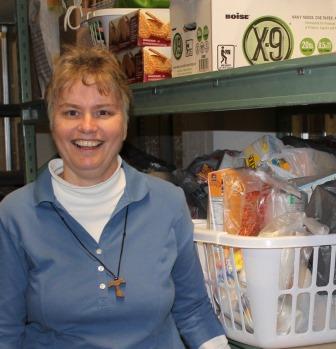
Sister Laurie, pictured here serving those in need at a food pantry.

From left to right, Sisters Laura Nettles, Eileen McKenzie, Katie Mitchell, Kristin Peters and Julia Walsh stand together on their Camino pilgrimage (photo courtesy of Sister Katie Mitchell).
The open road has also been a call to Sister Kristin Peters who just returned from a pilgrimage on the Camino de Santiago in Spain. As on some legs of her journey she was accompanied by her FSPA companions and on others she hiked alone, she discovered that her Camino experience mirrored religious life: you may walk with others but you also have to walk your own journey. Each step reveals insight. No one can walk for you, live for you. Sister Kristin's “yes” to religious life over the past 10 years has taken her to discover diverse paths to serve those with substance addiction and mental illness; to deliver, in ministry, help and compassion. She has ministered to many who others step over, walk past. It is no surprise that the image of Jesus as the Good Shepherd inspires her and is what she chose to guide her final vow liturgy. Sister Kristin listens and reflects the knowledge each person gains as they find their own way back into the sheepfold of our civic communities.
Sister Kristin receives her FSPA ring from Sister Blanche Klein.
Sister Romana Klaubauf receives her 50th Jubilee celebration corsage from Sister Karen Kappell.
A bit further down the road of religious life, Sisters Romana Klaubauf and Ester Leis shared their travel stories—their individual ministries—at a pre-jubilee pizza party. We watched a slide presentation of the sights they saw along their professions of 50 years, glimpsing decades of serving God's people and meeting new challenges in the changing landscapes of religious life. Mary of the Angels was filled to capacity as community members, family and friends gathered to witness their ongoing commitment. The readings they chose (Isaiah 43:1-10, Micah 6:8 and John 10) tell their stories of faithfulness to God.

Sister Esther Leis processes into Mass held in honor of her Golden Jubilee.
These three celebrations were each unique in time and experience yet all pointed to the goodness revealed through the faithfulness of “yes.” The song “I Say ‘Yes’ Lord/Digo ‘Sí’ Señor” by Donna Peña and Marty Haugen has been moving in my heart and mind as I ponder the blessing each of these celebrations have been. They are witnesses to our world of faithfulness and commitment in good times and challenges. We all walk terrain smooth and bumpy; mountainous and flat. God is with us in each step, and every breath of life.
This week as you consider your own location in discernment ask yourself ...
What are the celebrations marking my journey?
Is there a theme to my experience so far?
How am I relying on God?
Awake and ready in discernment?
Why is it that when we are excited about tomorrow it’s impossible to fall asleep? I can’t tell you how many nights I’ve watched the clock move slow as molasses towards morning and birthdays and holidays; community celebrations and time with family and friends. This past Sunday, as a church, we entered not only a new year but a season of waiting. The old adage circles in my mind: the more you wait the better it will be. While I am sure this is true sometimes, I can also be impatient and yearn to know now. My favorite Advent song is Patience, People by John Foley, SJ. It reminds me that how I wait is just as important as the waiting.

Photo by Sister Amy Taylor, FSPA
Advent has a dual focus of anticipation and action. It takes a lot of hard work to prepare your heart for Christmas; more than fragrant words of holy intention. Making space takes effort. Under the softened warm glow of preparation is the commitment to make things happen.
On the first Sunday of Advent we hear the words of the Prophet Isaiah and the Gospel of Matthew, each offering insight into this time of eagerness. Isaiah is the prophetic alarm clock awakening sleepy believers. With strong words he clamors above the din of lukewarm following. His message streams across divisions calling for unity and inviting us to walk in the ways of the Lord. Reverberations ring as the call for change clashes against the comforts of routine and acceptance.
Where do you find yourself as you reflect on the sword and the plow? Are you willing to pound your sword into a plow to cultivate ground for your discernment and co-create with God?
In the Gospel Matthew also shares sage advice: don’t be distracted and caught unprepared; be ready. When waiting, it’s easy to get distracted and lose focus. There may be less time than you think.
For all the wisdom and guidance Isaiah and Matthew provide, what is your attitude, in discernment, as you wait on God? When was the last time you pleaded with God to show you the way … "Now!"? Did you shout in anger? Threaten with an ultimatum? Storm away; frustrated because your discernment seems perpetually unresolved?
And so, this Advent, I invite you to take the opportunity to prepare your heart, to welcome the wakeful nights of uncertain discernment you’re experiencing right now.
Are you willing, in this moment, to wait?


